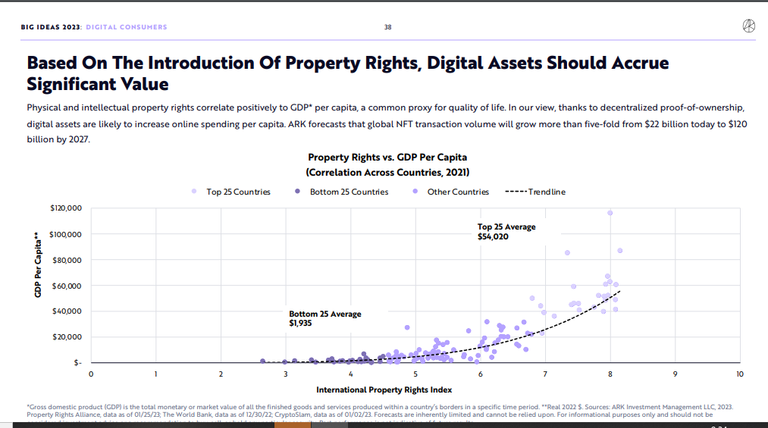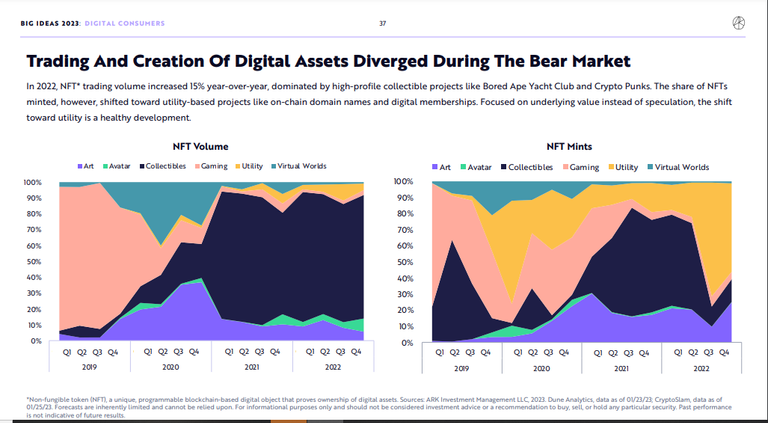Digital Assets Vision 2030 and the Value of Hive Blockchain: Navigating a New Economic Frontier Part 2
In my earlier post, I discussed the challenges of communicating the value of Hive blockchain to those living in the Web2 world. I emphasized the need to bridge the gap in language and understanding between Web3 and Web2 people to effectively communicate the benefits of Hive. I also mentioned the Vision 2030 plan of Saudi Arabia, which focuses on the Statist version of digitalization and financial inclusion. The ideas from the said introductory post rely on several articles available on the web on the subject as of 17 October 2023.
In this second part, I just want to introduce two graphs from Ark Invest, an overview of what digital assets are, the role of NFTs, and the prospects of digital assets by 2030. As for the value of the Hive blockchain, we will postpone the discussion until the last part of the series.
Two Graphs from Ark Invest

Based on the above graph, the prospects of digital assets are very promising. The research recognizes the role of decentralized entities in the growth of digital assets. Among these digital assets, Ark Invest gave its special attention to NFTs. The investment site even gave a very exciting forecast that I believe will be received gladly by those who invested early in the space:
. . . global NFT transaction volume will grow more than five-fold from $22 billion today to $120 billion by 2027.
If the analysts in Ark Invest are correct and you are already invested in the space, there is nothing to worry about regarding the future of your investment though at present you are anxious if you made the right decision due to the depressed price of your holdings.

The second chart shows that in the NFT space, gaming occupied the big portion in 2019 and is almost unrecognizable in 2022. However, the good news is that speculation in gaming is now being replaced by an emphasis on art, collectibles, and utility. Now that we are in the last quarter of 2023, I think the trend remains intact onwards.
Seeing the above two charts reminds me of my recent engagement with @alokkumar121 three days ago. He shared a post about his experience purchasing an SPS node validator license in the Splinterlands game a year ago, and how the value of the license has significantly decreased since then. As I read his article, I got the impression that he was reflecting on whether he made a strategic decision and whether he should purchase another license. I commented that the coming years will tell if his Splinterlands assets are worth it. And that's the time I referenced my reading of the Ark Invest material that based on the research, owning digital assets is the future, and that includes NFT cards and the SPS node validator license.
What are digital assets?
Digital assets are varied and here's where I find AI very useful. Though the bot enumerated numerous examples, I just want to focus on four of them:
digital currency,
digital art,
social media accounts, and
data and databases
Here's how AI describes digital assets:
Digital assets refer to any form of content or media that exists in a digital format and has economic value. These assets are stored and accessed electronically, making them intangible and distinct from physical assets. Digital assets can be owned or controlled by individuals, organizations, or entities, and they are often used for various purposes, including entertainment, business, education, and communication.
In the above description, both layer 1 and layer 2 currencies are classified as digital assets and so not only owning $HIVE and $HBD but also accumulating tribe tokens like $CENT, $SME, $POB, $SPORTS, and others are concrete and strategic ways of growing your digital assets. Of course, in a depressed market like what we have right now, it is easy to be discouraged looking at the current prices of these tokens. However, if digital assets are the future, I firmly believe that growing your stakes now is the wisest decision that you can make. But a warning is proper at this point. This kind of projection still depends on the kind of project or token that you decide to accumulate. Again, the increasing development, use cases, and potential future market demand of these tokens serve as more reliable indicators that you are in a solid project.
Shifting to social media accounts, imagine that if accounts on Web2 platforms can be considered digital assets especially if they have a large following, how much more the value of accounts on Web3 platforms like Hive?
Data and databases, as Jonathan Holt of KPMG argued would play a significant role in the future of fintech and will determine "how financial services will make money in 2030." Reading Pi Network's white paper in December 2021 and watching the documentary video The Social Dilemma published in 2020, I realized the role of data and databases in the growth of the wealth of big tech companies. They collect our information, and they analyze and monetize it without our permission. Now, with the advent of Web3 platforms, real data ownership is decentralized and anyone in any part of the world has an opportunity to grow this type of digital asset.
Other examples of digital assets include:
digital media
E-books and online publications
domain names
software - this includes mobile apps and games
digital photos, and
intellectual property that exists in electronic forms
At present, the value of digital assets remains volatile. Except for security considerations, a serious threat is coming from governmental legal, and regulatory bodies. These are things that one has to consider in investing in this space.
NFTs as a subset of digital art
As for NFTs, they fall under the category of digital art. They have gained significant attention with the rise of blockchain technology.
Joining Splinterlands in August of 2021, I had no idea what NFTs were but I got curious about them when I saw that there are battle cards, which are more expensive than a house and lot combined. I wonder how could that be possible. I didn't understand how things work in the NFT space. Now, that I see its value, my current goal is to keep collecting them.
The prospects of digital assets by 2030
Based on the existing track record of digital assets, AI identified some potential trends and developments that could shape its future by 2030:
Increased mainstream adoption and integration with traditional finance
Regulation and standardization
Environmental concerns
A more scalable and energy-efficient blockchain technology
Digital identity and security
Role of education in public awareness
Tokenizing physical assets, and
Genuine empowerment and economic and financial inclusion for the unbanked
Among the above eight trends, I don't like numbers 2 and 3 for they are more a product of mainstream politics and bureaucracy.
As for mainstream integration, I love to witness a world where I can pay for my morning coffee using digital currencies.
For the above integration to take place, I think education plays a vital role. Curriculums must be revised that include blockchain technology and cryptocurrency studies, ensuring that the younger generation is equipped with the knowledge necessary to navigate the intricacies of the digital economy.
Regarding tokenizing physical assets, this is the solution to the problem of the lack of asset class availability as identified in the Forbes article in my earlier post. I would be glad to see the expansion of digital assets that will include real estate and intellectual property rights. Imagine that these assets can be divided and shared into smaller units and anyone can own them even with a small amount of capital. Illiquid assets too could be offered in this way thereby opening up new investment opportunities, particularly for those who are excluded from the existing system.
Finally, about genuine empowerment and economic inclusion for the unbanked, the accessibility of digital assets can now bridge this gap. Anyone with an Internet connection is now included in the global economy, fostering economic growth. In time, as these individuals grow their digital assets over and above their monthly expenses the dream of financial freedom will be a reality.
Conclusion
The vision of digital assets by 2030 is not just an idea; it’s a reality in the making. As we journey deeper into the digital age, the way we perceive, create, and exchange value is transforming. In this brave new world, the potential for innovation knows no bounds. It's a future where the boundaries between the physical and digital blur, and where opportunity, creativity, and inclusivity reign supreme. The journey ahead is bound to be exciting, and transformative, and, most importantly, it is a "shared success," which I believe is one of the ethos promoted here on Hive as a digital nation.
https://inleo.io/threads/rzc24-nftbbg/re-rzc24-nftbbg-yho4fp9u
The rewards earned on this comment will go directly to the people ( rzc24-nftbbg ) sharing the post on LeoThreads,LikeTu,dBuzz.
It was a good discussion with you mate on my blog and this post is also good. You have explained the various aspects of digital assets and hive which is so good. I enjoyed reading it.
Yeah, I enjoy that, and the good thing with a decentralized blockchain like Hive is we can always check the previous conversations and reference them to expand existing ideas. Thanks for your time and appreciation. Blessings my friend.
#freecompliments
Hey buddy. Can you teach me how to quote nicely somebody elses words like you so when i post it doesn't look like everything that is being said is my work?
Posted using SoMee
No worries my buddy.
If you quote somebody's phrase or statement within your paragraph, you can use the open and close quotation mark: " . . . "
Just like what I did in the conclusion. The phrase "shared success" is not mine and that is why I put the phrase inside the open and close quotation mark.
However, if you want to quote the entire paragraph, "just add a right-facing arrow > at the beginning of your quote" just like what I did here:
I just added: >
I hope that helps.
You can check this markdown tutorial if you're curious to use other editorial functions.